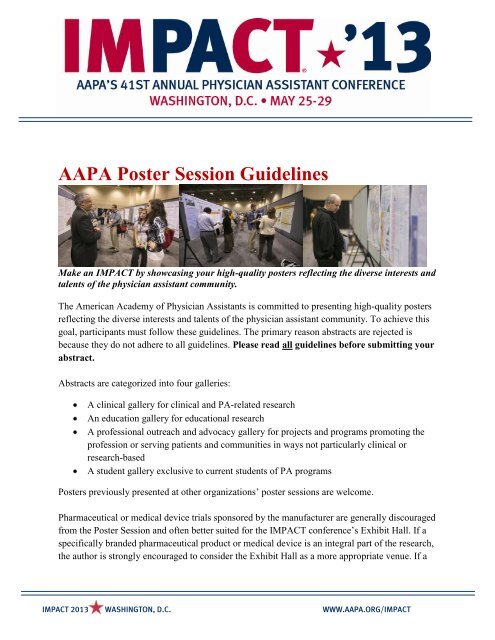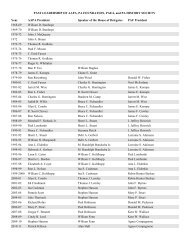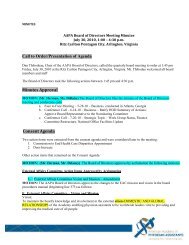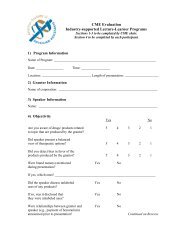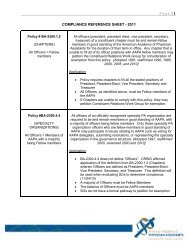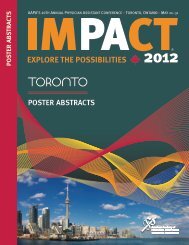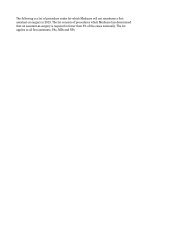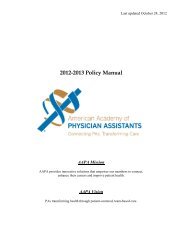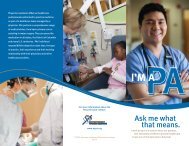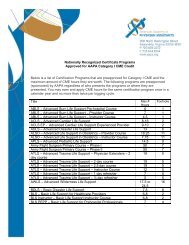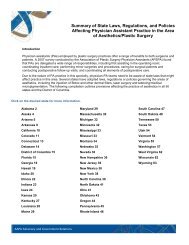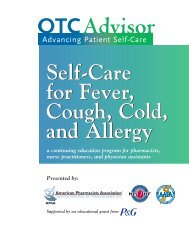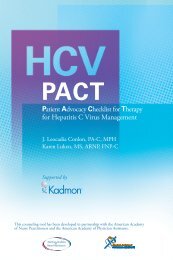AAPA Poster Session Guidelines - American Academy of Physician ...
AAPA Poster Session Guidelines - American Academy of Physician ...
AAPA Poster Session Guidelines - American Academy of Physician ...
Create successful ePaper yourself
Turn your PDF publications into a flip-book with our unique Google optimized e-Paper software.
<strong>AAPA</strong> <strong>Poster</strong> <strong>Session</strong> <strong>Guidelines</strong>Make an IMPACT by showcasing your high-quality posters reflecting the diverse interests andtalents <strong>of</strong> the physician assistant community.The <strong>American</strong> <strong>Academy</strong> <strong>of</strong> <strong>Physician</strong> Assistants is committed to presenting high-quality postersreflecting the diverse interests and talents <strong>of</strong> the physician assistant community. To achieve thisgoal, participants must follow these guidelines. The primary reason abstracts are rejected isbecause they do not adhere to all guidelines. Please read all guidelines before submitting yourabstract.Abstracts are categorized into four galleries:A clinical gallery for clinical and PA-related researchAn education gallery for educational researchA pr<strong>of</strong>essional outreach and advocacy gallery for projects and programs promoting thepr<strong>of</strong>ession or serving patients and communities in ways not particularly clinical orresearch-basedA student gallery exclusive to current students <strong>of</strong> PA programs<strong>Poster</strong>s previously presented at other organizations’ poster sessions are welcome.Pharmaceutical or medical device trials sponsored by the manufacturer are generally discouragedfrom the <strong>Poster</strong> <strong>Session</strong> and <strong>of</strong>ten better suited for the IMPACT conference’s Exhibit Hall. If aspecifically branded pharmaceutical product or medical device is an integral part <strong>of</strong> the research,the author is strongly encouraged to consider the Exhibit Hall as a more appropriate venue. If aIMPACT 2013 WASHINGTON, D.C. WWW.<strong>AAPA</strong>.ORG/IMPACT
specific brand, consumer product name or similar distracts viewers from the research value orcompromises the <strong>Poster</strong> <strong>Session</strong>’s spirit <strong>of</strong> integrity, the abstract will be rejected.Multiple submissions <strong>of</strong> similar abstracts from the same investigator are discouraged, andliterature reviews are not acceptable for poster presentation.There is a submission fee for every abstract submitted. The fee is $25 for <strong>AAPA</strong> members and$50 for nonmembers. This fee must be paid at time <strong>of</strong> submission.IMPACT 2013 WASHINGTON, D.C. WWW.<strong>AAPA</strong>.ORG/IMPACT 2
General RequirementsAll abstracts must be submitted by a medical pr<strong>of</strong>essional who can claim authorship for theproject. Authorship includes involvement in the conception and design, or analysis andinterpretation <strong>of</strong> data; drafting the article or revising it critically for intellectual content; and finalapproval <strong>of</strong> the version to be published. Authorship is not acceptable if the author only providesencouragement, physical facilities, financial support, critiques or editorial contributions.An individual may be the submitting author on no more than two abstracts, but cannot beincluded as an author on more than three. Authorship limitations may be waived for facultysponsoring students.The presenter is responsible for expenses associated with the submission, preparation andpresentation <strong>of</strong> posters.Presenters are required to pay the registration fee for attendance at the Annual Conference. Formore information on registration, please visit the Annual Conference Web page.Abstract General InformationAuthors must submit abstracts electronically through <strong>AAPA</strong>'s websitewww.aapa.org/postersession no later than January 16, 2013, at 11:59 p.m. Eastern StandardTime.Selection for participation in the poster session will be based on quality <strong>of</strong> research, clarity <strong>of</strong> theabstract and adherence to the guidelines.PAs, PA faculty and PA students are encouraged to submit abstracts describing original research.All author(s) must read the Disclosure Policy and Declaration Statementswww.aapa.org/postersession. Those submitting abstracts must disclose any known or potentialconflicts <strong>of</strong> interest, and any source <strong>of</strong> funding must be disclosed at the time <strong>of</strong> onlinesubmission.Accepted abstracts will be published in the IMPACT 2013 Annual Conference final program andon the <strong>AAPA</strong> website.Abstract Submission and Formatting <strong>Guidelines</strong>Authors must submit abstracts electronically through the online submission process. Visit<strong>AAPA</strong>'s Annual Conference Web page, select "<strong>Poster</strong> <strong>Session</strong>," and then select “Onlinesubmission form.” If you have a question or experience technical difficulties, e-mailIMPACT 2013 WASHINGTON, D.C. WWW.<strong>AAPA</strong>.ORG/IMPACT 3
<strong>Poster</strong><strong>Session</strong>@aapa.org. All abstracts must be received online by January 16, 2013, at 11:59p.m. Eastern Standard Time. Abstracts received after this deadline will not be accepted. Afterfilling out the online submission form, attach the abstract by one <strong>of</strong> the following methods:Type the abstract into the space providedCopy and paste the abstract from a word processing programAttach a Micros<strong>of</strong>t Office Word document to the formThe abstract text should not exceed 500 words (not including the title and author information).Titles should be brief and clearly indicate the abstract’s content. Capitalize the first letter <strong>of</strong> eachword, except prepositions. No abbreviations should be used in the title.Only standard abbreviations will be accepted. Special or unusual abbreviations should be placedin parentheses after the full word appears the first time. Arabic numerals should be used toindicate numbers, except when used in the beginning <strong>of</strong> a paragraph. Nonproprietary (generic)names <strong>of</strong> drugs should be used.Do not include tables, graphs, algorithms, pictures or references in the abstract. Abstracts thatinclude these will not be accepted.Accepted abstracts will be printed as submitted. Changes to abstracts will not be acceptedafter online submission. Abstracts should be edited and carefully reviewed prior tosubmission. A common reason abstracts are not accepted is significant typographical orgrammatical errors.Only the abstract’s author will receive all correspondence via e-mail from <strong>AAPA</strong>.Clinical Gallery <strong>Guidelines</strong>Clinical abstract presentations are divided into the following categories:Original research - study findings or other research projects not previously presented orpublishedClinical report/case studies - clinical case reports or clinical vignettes highlightingunusual cases or innovative approaches to clinical problems/techniquesPreviously presented - abstracts presented at another national or international medicalmeeting, scientific session, etc.Original research abstracts should be informative and include the following sections:Purpose - a brief statement explaining why the research was conducted, preferablylimited to one sentenceIMPACT 2013 WASHINGTON, D.C. WWW.<strong>AAPA</strong>.ORG/IMPACT 4
Methodology - materials, methodology and any analytical procedures applied, preferablylimited to two sentencesResults - should be presented in sufficient detail to support the conclusions(It is inadequate to state: "The results will be discussed" or "The data will be presented.")Conclusions - the authors' opinion about the meaning <strong>of</strong> the studyAbstracts submitted without final conclusions or results will not be accepted.Education Gallery <strong>Guidelines</strong>These guidelines should be followed in addition to those listed under the Abstract Submissionand Formatting <strong>Guidelines</strong>.Educational abstract presentations are divided into the following categories:Educational research - original research conducted in PA education including resultsfrom a grant-funded projectCurricular innovation - a descriptive poster about a new teaching method, learningopportunity or other innovative educational modality introduced into the clinical ordidactic phase <strong>of</strong> a PA programPreviously presented - abstracts presented at the <strong>Physician</strong> Assistants EducationAssociation's Annual Education Forum or other health pr<strong>of</strong>essions education venueEducational abstracts should clearly and completely describe the project. The format <strong>of</strong> theabstract should include a general description <strong>of</strong> the objective(s), rationale, methodology,evaluation, results and conclusions. It is desirable to highlight objectives that are uniquelyinnovative, have impact on special populations or have value to other PA educators. It is mostimportant to discuss measurable outcomes and data that support them. Abstracts that highlightcommunity-campus linkages, especially those that improve the health <strong>of</strong> underserved and diversepopulations, are particularly valued.Educational research abstracts will be peer-reviewed by PA educators and PAs familiar with PAeducation. PA education abstracts will be evaluated based on their overall quality, the level <strong>of</strong>innovation, inclusion <strong>of</strong> measurable outcomes and value to other PA educators.<strong>Poster</strong>s previously presented at the <strong>Physician</strong> Assistant Education Association Annual EducationForum can be submitted for the <strong>AAPA</strong> <strong>Poster</strong> <strong>Session</strong>. Authors should follow <strong>AAPA</strong>'ssubmission guidelines.IMPACT 2013 WASHINGTON, D.C. WWW.<strong>AAPA</strong>.ORG/IMPACT 5
Pr<strong>of</strong>essional Outreach and Advocacy Gallery <strong>Guidelines</strong>Participants should follow these guidelines in addition to those listed under the AbstractSubmission and Formatting <strong>Guidelines</strong>.Pr<strong>of</strong>essional outreach and advocacy abstract presentations are listed as follows:Outreach and advocacy activities designed to serve a community or patient populationOutreach and advocacy activities intended to promote the PA pr<strong>of</strong>essionOutreach and advocacy activities designed to demonstrate innovation in delivery <strong>of</strong>patient carePr<strong>of</strong>essional outreach and advocacy abstracts should be informative and include the followingsections:Purpose: a brief statement explaining why the project or program was conducted.Description: a description <strong>of</strong> the objectives and steps taken to achieve them. Highlightaspects <strong>of</strong> the project that are innovative, impact special populations or communities,build partnerships, are sustainable, add value to the PA pr<strong>of</strong>ession and/or are particularlytimely. Describe the plan to evaluate the success <strong>of</strong> the project or program.Results: should be presented in sufficient detail to support the conclusions.(It is inadequate to state: "The results will be discussed.")Conclusions: the authors' opinion about the impact <strong>of</strong> the project or program.Abstract AcknowledgementAfter you have successfully completed the submission application, you will receive an e-mailnotification confirming receipt <strong>of</strong> your abstract. If you have not received confirmation within 24hours, please contact <strong>Poster</strong><strong>Session</strong>@aapa.org.<strong>Poster</strong> <strong>Guidelines</strong><strong>Poster</strong>s should be no more than 4’ x 8’ (48” X 96”) and no less than 3’ x 4’ (36” X 48”). <strong>Poster</strong>smust include a title, author or authors’ names, abstract, purpose, methodology, results andconclusions. All subtitles and texts should be readable from two to three feet away. Avoid theuse <strong>of</strong> script fonts that are difficult to read.The poster should have the title placed at the top with the authors' names and affiliations(optional) beneath it. The title should match that submitted with the abstract. The poster shouldalso include a copy <strong>of</strong> the abstract and expanded sections <strong>of</strong> the purpose, methodology, resultsand conclusions as appropriate to the type <strong>of</strong> abstract.IMPACT 2013 WASHINGTON, D.C. WWW.<strong>AAPA</strong>.ORG/IMPACT 6


